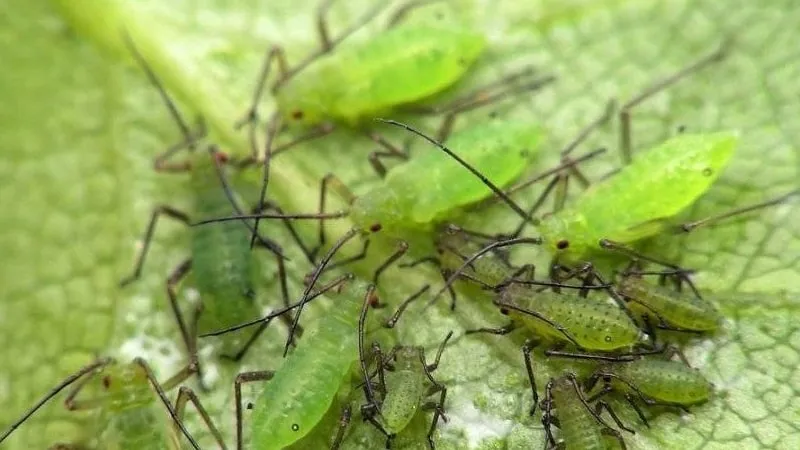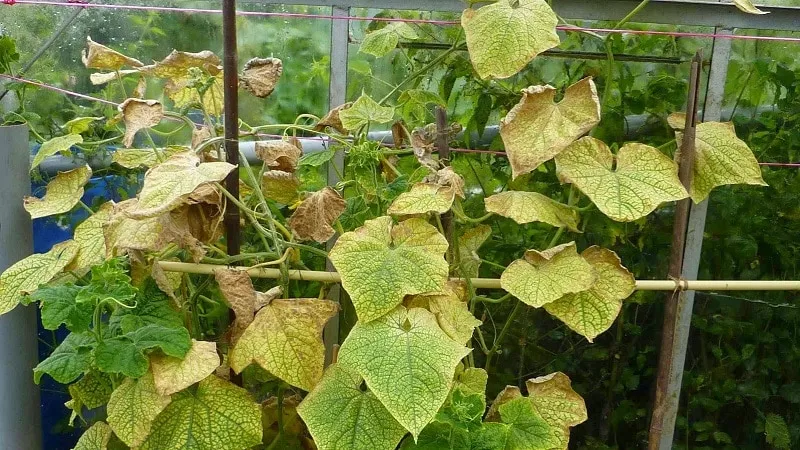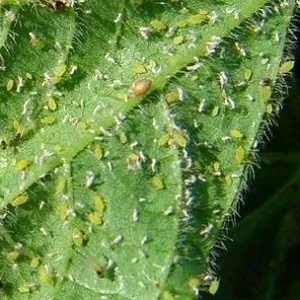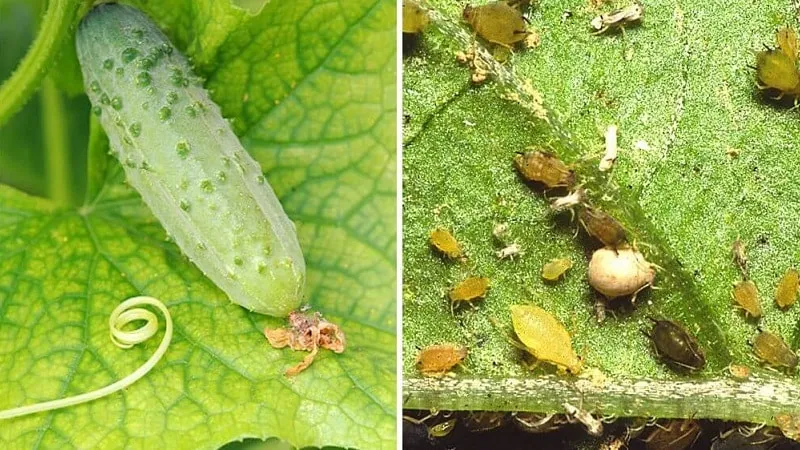Cucumbers are an undemanding crop with simple cultivation techniques and minimal care. However, cucumbers are a favorite snack for various pests. One of the most dangerous and voracious is the melon aphid. This parasite multiplies rapidly and destroys plants and crops.
From this article, you will learn everything about melon aphids and how to combat this pest.
Table of contents
What is this pest?
The melon aphid, or cotton aphid, belongs to the class of insects and the family Aphididae.
This type of aphid affects more than 330 plant species: cucumbers, watermelons, melons, pumpkins, cotton, tobacco, and others.
In the weather conditions of Central Europe, it becomes active in the first half of July. In greenhouses, cucumbers can be attacked by the pest as early as mid-May.
The parasite is widespread everywhere.
What it looks like
The insect measures 3-4 mm in size. The body of the melon aphid is elongated, tapering toward the rear tip. The body is colored in various shades of green, while the legs and antennae are dark brown or black. Both winged and wingless individuals exist.
The mouthparts are of the sucking type, equipped with a proboscis that pierces plant tissues and extracts cell sap.
Our photos will help you identify the pest.

Reproduction
In spring, the colony begins with larvae. They hatch from eggs laid on weeds in autumn when the air temperature reaches +5°C. The larvae can overwinter under the leaves of wintergreen plants, such as in greenhouses.
After molting, the larvae turn into wingless females and begin asexual reproduction.
As the colony grows denser, winged individuals appear, flying or being carried by the wind to neighboring plants, where they form new colonies.
Over the summer, dozens of generations of females are born, with the offspring of a single larva reaching tens of thousands of individuals.
In autumn, winged males appear and fertilize the females, which then lay eggs. This offspring is capable of surviving the winter and starting the next life cycle.
How to recognize melon aphid infestation on cucumbers
On cucumbers affected by aphids, the leaves droop, curl, and fade. Flowers and ovaries fall off.

On the underside of the leaves, tiny insects and a shiny, thin film of sugary aphid secretions are visible. As the colony grows, the insects settle on stems, buds, and young shoots.
Damage caused
The parasites pierce cucumber leaves with their proboscis and feed on their sap. The leaf blade wrinkles and dries out. Photosynthesis and nutrient production are suppressed. Growth and fruit formation slow down.
If left unchecked, an aphid colony can lead to plant death and complete crop loss.
Additionally, aphids transmit viral diseases, so an infestation is often accompanied by outbreaks of cucumber mosaic virus.
Causes of appearance
Aphids thrive in high temperatures and humidity.
The pest actively multiplies and spreads if:
- there are few natural predators in the area — ladybugs and their larvae, lacewings, sand wasps;
- there are many ants on the beds, which carry aphids onto plants and protect them from predators.
How to combat
Eliminating aphids is not difficult, as the insect is susceptible to various pesticides.
For successful control, follow two rules:
- Simultaneously with aphid elimination, take measures to eradicate ants.
- When applying any treatment, ensure coverage of both the upper and lower sides of the leaves.
Chemical pesticides
Powerful insecticides effective against aphids include:
- Confidor (Imidacloprid) — a systemic insecticide. The active ingredient is imidacloprid. Available as a liquid concentrate. For the working solution, dilute 1 ml in 10 liters of water. Apply in the early morning or evening. The last treatment should be at least 30 days before harvest.
- Decis Pro (Deltamethrin) — a contact and stomach poison based on deltamethrin. Packaged in various-sized bottles. For cucumber treatment, dissolve 5 ml in 20 liters of water. Spray at the first sign of aphids, repeating after 2 weeks if necessary. The pre-harvest interval is 20 days.
- Karate Zeon (Lambda-cyhalothrin) — a contact and stomach insecticide. The active ingredient is lambda-cyhalothrin. For aphid control, dilute 2 ml in 10 liters of water. Apply during the growing season, at least 20 days before harvest.
Important! Always wear protective clothing, gloves, and a mask when handling chemicals. Wash hands and face thoroughly after use, and launder clothing.
Biological agents
Biological pesticides are less toxic to humans and beneficial insects. They have a delayed effect, with pests dying 1-3 days after treatment.
Popular options among European gardeners include Spinosad and Neem oil, which have neuroparalytic effects on pests.
| Product | Active ingredient | Working solution preparation | Number of treatments | Application rate | Pre-harvest interval |
| Spinosad | Spinosyn A and D | 2 ml per 1 liter of water | 1-2 treatments, 2-3 weeks apart | 100 ml per 1 m² | 1-3 days |
| Neem oil | Azadirachtin | 5 ml per 1 liter of water | 1-2 treatments, 2 weeks apart | Spray until leaves are fully wet | 2 days |
Note. The preparation and application rates are for combating aphids on cucumbers. For other crops or pests, always check the product instructions.
Home remedies
 Budget-friendly home remedies are effective for prevention and early-stage infestations.
Budget-friendly home remedies are effective for prevention and early-stage infestations.
Common recipes include:
- Nicotine spray — 300 g of dried tobacco leaves soaked in 10 liters of water for 2 days, strained, and mixed with 70 g of grated tar soap.
- Vinegar solution — 7 tbsp of 9% vinegar diluted in 10 liters of water.
- Hot pepper spray — 50 g of crushed red chili peppers steeped in 1 liter of boiling water for 2 hours, strained, and diluted in 10 liters of water.
- Marigold infusion — 200-300 g of dried marigold flowers soaked in 10 liters of water for 24 hours, then strained.
- Garlic spray — 500 g of crushed garlic soaked in 3 liters of water for 5 days. For the working solution, use 50 ml of concentrate per 10 liters of water.
- Wood ash and soap — 50 g of wood ash and 70 g of grated laundry soap mixed in 10 liters of water.
Spray plants with one of these solutions weekly until the aphids disappear. The optimal application rate is 1 liter per 10 m².
Plants that repel aphids
To create a natural barrier, plant aromatic herbs near cucumber beds: garlic, marigolds, coriander, fennel, basil, thyme, or peppermint.
Preventive measures
The risk of aphid infestation decreases with proper plant care, so maintain a consistent watering and fertilization schedule.
Effective preventive measures include:
- Controlling ant populations. Use ant baits like AntStop or Nippon Ant Killer.
- Disinfecting greenhouse structures and soil with bleach (400 g per 10 liters of water) before planting.
- Thoroughly removing all plant debris from beds, as aphid larvae can overwinter on weeds and old foliage.
- Following proper planting density: no more than 4 cucumber plants per 1 m². Overcrowding encourages pest spread.
- Regular plant inspections. Weekly checks help detect pests early.

Tips and recommendations
Experienced gardeners recommend planting disease-resistant cucumber varieties. These have strong root systems, vigorous growth, and recover faster from pest attacks. Consider hybrids like Corinto F1, Excelsior F1, or Picolino F1.
Attracting birds and beneficial insects helps control aphids. Install bird feeders to encourage sparrows and tits. Planting dill and mustard near cucumbers attracts ladybugs — natural aphid predators.
Conclusion
Aphids are tiny but voracious insects that attack cucumbers and other crops. By feeding on plant sap, they damage crops and reduce yields. Chemical and biological pesticides are effective against aphids, while home remedies work for minor infestations.
Encouraging birds and beneficial insects helps reduce aphid populations. Since ants spread aphids, controlling them is key to prevention. Regular leaf inspections help detect infestations early and save your harvest.







